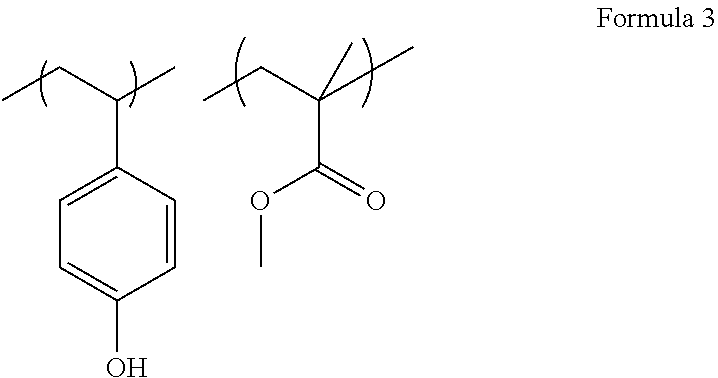Film forming composition containing fluorine-containing surfactant
a technology of surfactant and film, applied in the field of film forming composition, can solve the problems of unnecessary residue generated on the semiconductor substrate, unnecessary residue that cannot be removed,
- Summary
- Abstract
- Description
- Claims
- Application Information
AI Technical Summary
Benefits of technology
Problems solved by technology
Method used
Image
Examples
synthesis example 1
[0095]15.0 g of an epoxy cresol novolac resin (manufactured by Asahi Ciba Co., Ltd., trade name: ECN1299), 10.2 g of 4-hydroxybenzaldehyde (manufactured by Tokyo Chemical Industry Co., Ltd.), and 0.08 g of tetramethylammonium hydroxide (manufactured by Tokyo Chemical Industry Co., Ltd.) were dissolved in 60.0 g of propylene glycol monomethyl ether and then reacted at 130° C. for 6 hours. Then, the solution temperature was decreased to 60° C., and 5.5 g of malononitrile (manufactured by Tokyo Chemical Industry Co., Ltd.) was added to be reacted for 2 hours and, thus, to obtain a solution containing a resin.
[0096]When the obtained resin was subjected to a GPC analysis, the resin was found to have a weight average molecular weight of 3,300 in terms of standard polystyrene. The obtained resin is considered to be a resin (referred to as the coating film resin 1) having a repeating unit structure of Formula 1.
synthesis example 2
[0097]100 g of monoallyl diglycidyl isocyanuric acid (manufactured by Shikoku Chemicals Corporation), 66.4 g of 5,5-diethyl barbituric acid, and 4.1 g of benzyltriethyl ammonium chloride were dissolved in 682 g of propylene glycol monomethyl ether and then reacted at 130° C. for 24 hours to obtain a solution containing a polymer. When the obtained polymer was subjected to a GPC analysis, the polymer was found to have a weight average molecular weight of 6,800 in terms of standard polystyrene. The obtained resin is considered to be a resin (referred to as the coating film resin 2) having a repeating unit structure of Formula 2.
synthesis example 3
[0098]15.0 g of p-t-butoxystyrene (manufactured by Tosoh Corporation, trade name: PTBS), 19.9 g of methyl methacrylate (manufactured by Tokyo Chemical Industry Co., Ltd.), and 2.1 g of 2,2′-azobis (isobutyric acid) dimethyl (manufactured by Wako Pure Chemical Industries, Ltd.) were dissolved in 86.3 g of propylene glycol monomethyl ether, and the solution was added dropwise into 61.6 g of propylene glycol monomethyl ether heated to 80° C. in a nitrogen atmosphere. After the completion of the dropwise addition, the reaction was continued for 18 hours while maintaining a temperature of 80° C. Then, the reaction mixed solution was added dropwise into diethyether-hexane to precipitate a resin. When the obtained resin was subjected to a GPC analysis, the resin was found to have a weight average molecular weight of 12,000 in terms of standard polystyrene.
[0099]20.0 g of the obtained resin was dissolved in 100 g of acetone. 1.0 g of 1N-hydrochloric acid was added dropwise while heating to ...
PUM
| Property | Measurement | Unit |
|---|---|---|
| wavelength | aaaaa | aaaaa |
| wavelength | aaaaa | aaaaa |
| wavelength | aaaaa | aaaaa |
Abstract
Description
Claims
Application Information
 Login to View More
Login to View More - R&D
- Intellectual Property
- Life Sciences
- Materials
- Tech Scout
- Unparalleled Data Quality
- Higher Quality Content
- 60% Fewer Hallucinations
Browse by: Latest US Patents, China's latest patents, Technical Efficacy Thesaurus, Application Domain, Technology Topic, Popular Technical Reports.
© 2025 PatSnap. All rights reserved.Legal|Privacy policy|Modern Slavery Act Transparency Statement|Sitemap|About US| Contact US: help@patsnap.com



